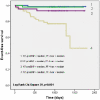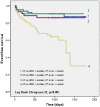PF-4var/CXCL4L1 predicts outcome in stable coronary artery disease patients with preserved left ventricular function
- PMID: 22384011
- PMCID: PMC3285621
- DOI: 10.1371/journal.pone.0031343
PF-4var/CXCL4L1 predicts outcome in stable coronary artery disease patients with preserved left ventricular function
Abstract
Background: Platelet-derived chemokines are implicated in several aspects of vascular biology. However, for the chemokine platelet factor 4 variant (PF-4var/CXCL4L1), released by platelets during thrombosis and with different properties as compared to PF-4/CXCL4, its role in heart disease is not yet studied. We evaluated the determinants and prognostic value of the platelet-derived chemokines PF-4var, PF-4 and RANTES/CCL5 in patients with stable coronary artery disease (CAD).
Methodology/principal findings: From 205 consecutive patients with stable CAD and preserved left ventricular (LV) function, blood samples were taken at inclusion and were analyzed for PF-4var, RANTES, platelet factor-4 and N-terminal pro-B-type natriuretic peptide (NT-proBNP). Patients were followed (median follow-up 2.5 years) for the combined endpoint of cardiac death, non-fatal acute myocardial infarction, stroke or hospitalization for heart failure. Independent determinants of PF-4var levels (median 10 ng/ml; interquartile range 8-16 ng/ml) were age, gender and circulating platelet number. Patients who experienced cardiac events (n = 20) during follow-up showed lower levels of PF-4var (8.5 [5.3-10] ng/ml versus 12 [8-16] ng/ml, p = 0.033). ROC analysis for events showed an area under the curve (AUC) of 0.82 (95% CI 0.73-0.90, p<0.001) for higher NT-proBNP levels and an AUC of 0.32 (95% CI 0.19-0.45, p = 0.009) for lower PF-4var levels. Cox proportional hazard analysis showed that PF-4var has an independent prognostic value on top of NT-proBNP.
Conclusions: We conclude that low PF-4var/CXCL4L1 levels are associated with a poor outcome in patients with stable CAD and preserved LV function. This prognostic value is independent of NT-proBNP levels, suggesting that both neurohormonal and platelet-related factors determine outcome in these patients.
Conflict of interest statement
Figures



References
-
- von Hundelshausen P, Petersen F, Brandt E. Platelet-derived chemokines in vascular biology. Thromb Haemost. 2007;97:704–713. - PubMed
-
- Struyf S, Burdick MD, Proost P, Van Damme J, Strieter RM. Platelets release CXCL4L1, a nonallelic variant of the chemokine platelet factor-4/CXCL4 and potent inhibitor of angiogenesis. Circ Res. 2004;95:855–857. - PubMed
-
- Vandercappellen J, Van Damme J, Struyf S. The role of the CXC chemokines platelet factor-4 (CXCL4/PF-4) and its variant (CXCL4L1/PF-4var) in inflammation, angiogenesis and cancer. Cytokine Growth Factor Rev. 2011;22:1–18. - PubMed
-
- Struyf S, Burdick MD, Peeters E, Van den Broeck K, Dillen C, et al. Platelet factor-4 variant chemokine CXCL4L1 inhibits melanoma and lung carcinoma growth and metastasis by preventing angiogenesis. Cancer Res. 2007;67:5940–5948. - PubMed
-
- Charo IF, Ransohoff RM. The many roles of chemokines and chemokine receptors in inflammation. N Engl J Med. 2006;354:610–621. - PubMed
Publication types
MeSH terms
Substances
LinkOut - more resources
Full Text Sources
Other Literature Sources
Medical
Research Materials
Miscellaneous

